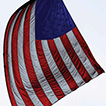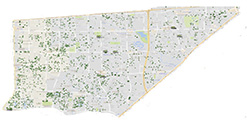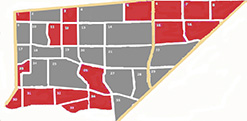Finding “Fourth-Soil” People: American Context

A couple of years ago on a college campus, I watched a group of college students help their fellow student find his lost dorm key in a grassy field. The student could not retrace his exact steps, so his fellow students searched and roamed aimlessly.
To expedite the search, I stepped in and asked the students to form one line and walk together in unison, covering one section at a time. In a matter of moments, the students swept the field and the student was reunited with his key. Inside a missionary’s target working area awaits a movement catalyst. Jesus not only provided us His plan for finding fourth-soil individuals; He modeled it in pre-Pentecost Galilee.
Let’s apply lessons learned from Jesus and his ministry to the U.S. context and use all the tools and resources available to help missionaries find Fourth-Soil People among the many unreached people groups residing within our borders. Churches as well can adopt unreached people groups in specific geographic locations. Plans and tools are only beneficial when used.
Establish a Target
Jesus began His ministry with a specific target, the lost house of Israel in Galilee. In my own ministry, I discovered that when I did not have a specific target, I hit nothing. As well, when I had multiple targets, I also failed because of distractions. The first step of establishing an unreached people group movement in the U.S. involves choosing a people group or population segment within a geographic location. This represents your Galilee. Keepin mind that Jesus’ seed-sowing ministry in Galilee lasted one to two years. Patience and extended commitment to the goal of finding movement catalysts are required.
A valuable tool assisting missionaries to establish their target people group or population segment in a geographic location is available from Mapping Center for Evangelism and Church Growth1 (www.mappingcenter.org), which uses the latest consumer data (used by Fortune 500 companies for marketing purposes) and merges it with current mapping technology. With the Mapping Center tool, I created my Galilee in my city. The map below showed me 2,761 probable Muslim homes, representing my target people group. To help me systematically sow my field with the gospel, I used natural boundary lines (major roads) to create smaller sowing fields (second map).


After one year of work, 811 of 2,761 resident homes of my target people group received a knock on the door. Residents at home during our seed-sowing campaigns (20 percent were home) heard the gospel, and we gave them a copy of the Gospel of Luke and a JESUS film. For the remaining 80 percent we left in a pouch hung on their door the Gospel of Luke and a JESUS film.
Besides going door to door, our team of missionaries interact with Muslims in and around our Galilee by eating at Muslim restaurants, frequenting the many mosques, shopping at Muslim stores and interacting with them at soccer games. Most of the thirty-four Muslims who professed Jesus as their Savior up to this point came through a team member living in a Muslim-majority apartment complex. Along with volunteers, our mission team averages sixty gospel shares per month in and around our Galilee. We estimate a total of two years to cover our Galilee, as best as we know how, as Jesus covered his Galilee. At this point, three of the thirty-four former Muslims shared the gospel with immediate family members, the remaining lived in fear or worry about how to survive financially.
We Are Not the Only Sowers in Our Galilee
Unlike Jesus’ Galilee, our Galilee had sowers living within its borders before we adopted the target area. In a highly restricted Muslim country, one of my team members visited a like-minded mission organization conducting a Bible correspondence program with thousands of Muslim graduates. The team member visited the Bible correspondence office and asked for assistance in locating a person. The Bible correspondence representative gladly responded with an offer to help, but he needed a description of the person the missionary had in mind. The missionary asked if any of their graduates met the profile of a Fourth-Soil Person. From the description, a representative of the Bible correspondence arranged for my team member to meet three graduates. From those three former Muslims, more than five hundred Muslims had accepted Jesus as their Savior and received baptism.
Considering this, our hometown team spends a fourth of its time connecting with churches in our Galilee asking if they know of any Muslim converts who meet the profile of a Fourth-Soil Person. Many churches have ESL programs or refugee ministries; we ask them the same. Churches and organizations often serve as lighthouses for Fourth-Soil People and need to be trained in what to do and not do with potential movement catalysts.
Preaching an accurate understanding of the Parable of the Sower to churches has a correlation with the FBI’s actions of disseminating their “Top 10 Most Wanted” list, which contains profiles of people they intend to find. Every opportunity I have to speak at a church, I exposit the Parable of the Sower and use it as a means of disseminating my “Top Fourth-Soil Most Wanted” list. Knowing that church members work alongside, sit next to at school, shop from, and do business with the people group in my target Galilee, my goal involves presenting a profile of fourth-soil individuals so that church members will in turn inform me of potential Fourth-Soil People sightings.
Hot Coals
Jesus mobilized 120 Galileans from the Galilean movement to ignite the Jerusalem movement on Pentecost. A strategy growing in popularity outside the U.S. that should be employed in the U.S. involves temporarily extracting fourth-soil individuals from existing overseas movements and dropping them into a U.S. missionary’s Galilee. From a single hot coal of a fire, many new fires can ignite. Because a “hot coal” (person) comes from the same or near-culture targeted people group and has experience with the makings of a movement, a hot coal comes with advantages over an American missionary. With this approach, the Fourth- Soil Person works in the missionary’s Galilee to find Fourth-Soil People and does so without the oikos factor. Faced with a situation of not having the Fourth-Soil Person’s oikos, a hot coal must function as a sower, same as the missionary. From my experience with the hot-coal strategy, hot coals typically sow on a level that typically supersedes the work of the missionary. In my state, two Hindu temples and one mosque have been closed due to the work of overseas hot coals.
Conclusion
The Parable of the Sower informs missionaries that a catalyst for a fourth-soil movement exists, and the process of finding this person occurs best through large-scale, gospel-sowing campaigns followed by careful examination of germinated seeds (new believers). The usefulness of the parable for missionaries stands on many factors, including the use of good hermeneutics to understand the parable, the missionary assuming the role of the sower rather than of the Fourth-Soil Person, and the missionary viewing the Parable of the Sower as the best approach for multiplicative results.
1 The Mapping Center claims their accuracy of data is 86 percent accurate. Data for apartment complexes appear less accurate. All information is public data, and the program includes numerous features assisting missionaries not only to identify a people group, but also to keep track with seed-sowing progress.









comments